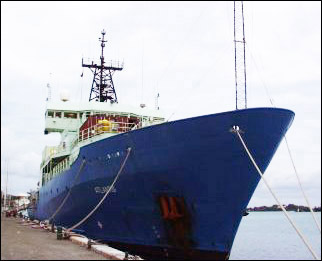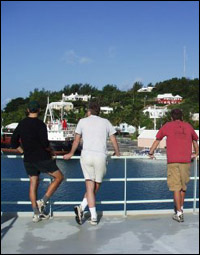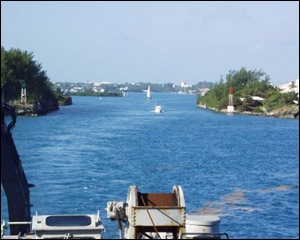
Leaving port ...
At mid-morning Saturday, Nov. 11, R/V Atlantis negotiated a narrow channel cut through solid rock to leave behind St. George, Bermuda . Looking back at the pastel tinted historic town, it was hard to envision that the tiny nation of islands, each surrounded by reefs and built on 200-foot thick limestone deposits, is actually the top of a huge extinct volcano that plunges over 4 kilometers 14,000 feet) to the deep ocean bottom.
Fig. 1. The R/V Atlantis in port at St. George, Bermuda.
About four days' steaming time away, where the research ship is bound at 12 ½ knots, new ocean crust is slowly being created along the Mid-Atlantic Ridge, one of the volcanically active undersea zones that gird our entire planet like a baseball's seams.  These are thought to define the surface edges of the huge plates of dense rock that underlie all the oceans and also carry the less-dense continents along for the ride like shells atop turtles.
Near the domed underwater mountain of interest to this expedition, plates bearing North America and Africa are creeping apart from each other at about 24 millimeters - 0.8 inches - a year. These are thought to define the surface edges of the huge plates of dense rock that underlie all the oceans and also carry the less-dense continents along for the ride like shells atop turtles.
Near the domed underwater mountain of interest to this expedition, plates bearing North America and Africa are creeping apart from each other at about 24 millimeters - 0.8 inches - a year.
Fig. 2. Leaving port.
Under the theory of "plate tectonics," which Joe Cann - a veteran ocean ridge expert on the cruise from the University of Leeds in England - saw come into being in the 1960, it is no accident that the coastlines of North and South America fit those of Europe and Africa like pieces of a jigsaw puzzle. All were once part of a supercontinent that broke apart about 180 million years ago when the plates underlying them began diverging, driven in some way by heat from the "mantle," Earth's subterranean mid region. The jagged line of separation became the eastern and western edges of the Atlantic, which slowly continues to widen today as new crust is created along the Mid-Atlantic Ridge.

The same plate separation and continental migration is underway elsewhere on the planet. In the process, Earth is constantly repaving the floors of its oceans as hot magma upwells from the mantle through cracks along the ridge lines where the plates are parting. The magma reaches the surface as molten lava, which flows out from the spreading center as it cools. This process both heals the cracks and makes new crust, which begins to age as it creeps down the slopes and away from the spreading center like a stone glacier.
Fig. 3. A narrow exit for the large Atlantis.

|








